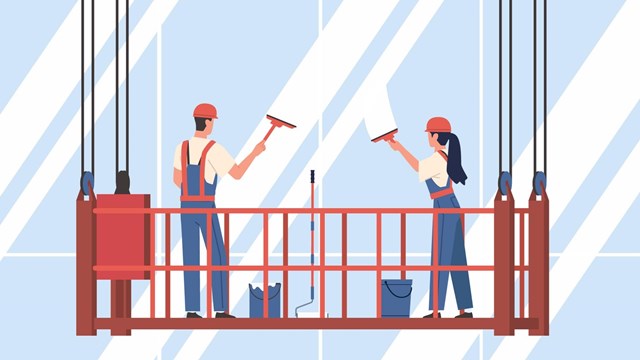Chicago is a city known for its harsh weather, but this winter was extremely trying, complete with a 'polar vortex' and more snow and ice than usual. But there is always the promise of springtime and all it entails—blossoming trees, the return of singing birds and green grass. But just like the maintenance and care necessary to keep the grounds clean and safe in winter, landscaping becomes a critical challenge during spring, summer and fall.
Blue Grass, Not Music
Kentucky bluegrass is by far the most commonly found type of lawn covering in Chicagoland. Kentucky bluegrass is a dense grass with smooth upright stems that can be planted from seed or sod, and is one of the most popular turf grass lawns in North America. The grass color ranges from bright green to deep, bluish green. It’s often used in low to medium traffic areas and often incorporated with other grass species to produce a better multipurpose lawn.
“Most associations have a bluegrass mix,” says Sherman Fields, vice president of Acres Group in Chicago. “Kentucky bluegrass is usually a mix of bluegrass, perennial rye and fescue. The advantage is that it's a soft, family friendly mixture of grasses that is very aesthetically pleasing. It's a cool weather grass so it does well in our zone.”
Bob Dore, president of Green Scene Landscaping & Lawn Care in St. Charles, agrees with Fields on the popularity of Kentucky bluegrasss in the Chicagoland area. “Because of the growing zone we're in Kentucky bluegrass is a popular choice,” he says. “It's a cool season grass, meaning that in the spring and fall it stays green and goes dormant in the summertime and there is no precipitation. It's important to hire professionals because it has to be planted in the right place.”
It is for that reason that Dan Kimble, general manager of Harmony Lawn Care, a Florida-based professional, recommends using outside contractors for lawn care, rather than opting to have in-house maintenance or grounds staff carry out the tasks of fertilizing, watering, and mowing.
“The way it’s usually done is that the management company for the building or association hires an outside company for lawn care, “says Kimble. “We will mow the lawn, take care of the maintenance, trim the hedges and do the fertilization. It’s important to have a professional do it because you need certain certification to do fertilization.”
“Lawn care in a condo development of building is almost always contracted to a professional landscape company,” says Fields. “It's very rare that the homeowners are responsible for that. It's usually part of the overall maintenance contract. In most cases, the property manager will go out and solicit proposals or bids from contractors. Then all of the bids will be presented at a board meeting and a contractor will be hired.”
Dore notes that on rare occasions properties will have an in-house landscaper who will either subcontract the fertilization part out or the landscapers themselves will do it. “In most cases they will hire outside contractors,” he says. “You'll work with a property manager, they are the ones who take the bids and then present them to the board and then they decide who they want to go with.”
Reap What You Sow
The majority of grass types found on residential lawns throughout Chicagoland are not naturally occurring so there are rules and guidelines to maintaining a lush, green lawn.
“Most landscape companies recommend a three-step plan, but we recommend a four-step plan says Fields. “The first step would be a spring fertilization with a pre-emergent. You use the pre-emergent to minimize crabgrass. It does not allow the crabgrass to germinate. Step two would take place in six-to-eight week intervals and that would be a straight fertilization or a fertilization with a broad leaf weed control. That is for the appearance, health and vitality of the grass, by that time things like dandelion and thistle weeds would have sprouted. Those can only be killed if they've already germinated and come above ground. The broad leaf weed control is a topical weed control so when it touches the actual plant it can kill it off. The third step is fertilization, you are just feeding your turf and keeping it healthy. Sometimes it comes with a weed control but not always. And the fourth step that we recommend is a feed fertilization. That allows the plant to store food in its roots. It's strictly for root development. The benefit of that is it comes out of spring healthier with more vitality.”
“Fertilization is key,” adds Dore. “It should be done five to six times a year. Your pre-emergent control in your early spring application should be done on an annual basis. There's also a preventative grub control that you can put down for your turf eating insects or a preventative application to prevent the grubs. They can basically destroy a lawn overnight.”
Chemical Balance
Historically, potent chemicals were used to combat unwanted growth such as weeds, crabgrass and nuisance plants, but many of these were deemed unsafe for both people and the environment, and subsequent legislation outlawed the use of many of them. In recent years, there has been a movement toward organic remedies, although certain approved chemicals are still administered.
In order to prevent health hazards and environmental damage, all landscape companies who apply fertilizer and weed killers will be required in 2014 to have the proper training and license to do so.
“The Department of Agriculture does have rules and guidelines for commercial landscapers,” says Fields. “Along with those guidelines, the landscaper should produce a MSDS [Material Safety Data Sheet] sheet upon demand. It gives you the chemical breakdowns. By law, every landscaper is required to carry an MSDS sheet. Let's just say there was a chemical applied by the landscaper or some other contractor and a mom is really frightened of her kid ingesting some of it. If the kid has a bad reaction, a doctor is going to immediately reach for that MSDS sheet.”
Industry experts note that there are non-chemical herbicides such as corn gluten meal and citric acid based products that have been proven to be effective; however, these products do tend to be more expensive than old-school remedies.
While early due diligence can be effective in thwarting unwanted growth such as crabgrass, transitional areas such as edges where a lawn meets paved surfaces can be challenging. In these spots of compacted turf, crabgrass can—and will often persist, even if pre-emergence applications are made.
“There are a number of weed and nuisance plants that are typical to the Chicago area but the biggest problem among trees is the ash borer,” says Dore. “This borer is killing off all of the ash trees in our area, not only in Chicago and Illinois, but in other states as well. There are treatments that can be used but most of the time it's too late and you have to cut them down.”
The glittering green beetle, which is about half-an-inch long, has moved across the U.S. since it was first found near Detroit, Michigan in 2002. It has since spread to 22 states and two Canadian provinces, killing more than 100 million trees in the process.
Landscaping Takeaways
Whether an association hires an outside contractor or allows the management company to handle landscaping duties, there are industry protocols underscoring best practices. Landscape committees or property managers should always ask for recommendations as well as licenses, certifications and insurance from vendors.
Experts believe that the future of landscaping is sustainability and working with Mother Nature. It’s important to plant and adapt to the specific environment rather than the aesthetics of the environment based on individual wants.
There are a number of organizations that boards, landscape committees and property managers can turn to for guidance. For example, the Illinois Landscape Contractors Association offers a wealth of information on everything from choosing a contractor to legislative updates. For additional information log onto www.landscapemanagement.net/tag/illinois.
W.B. King is a freelance writer and a frequent contributor to The Chicagoland Cooperator. Staff writer Christy Smith-Sloman contributed to this article.







Leave a Comment